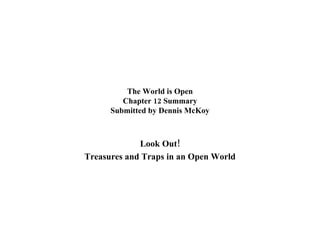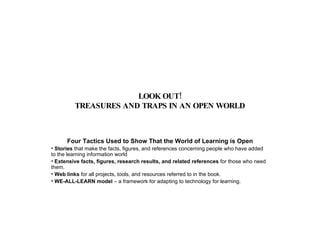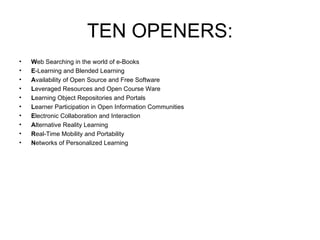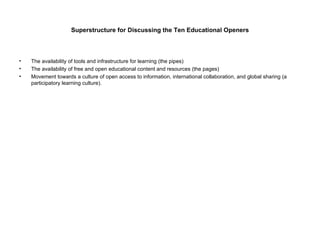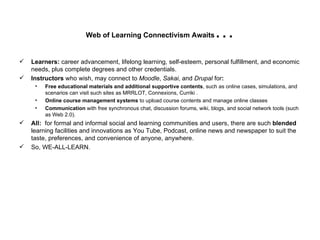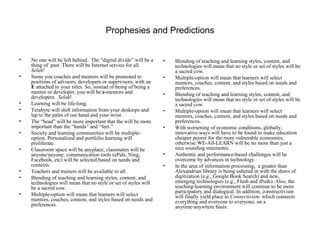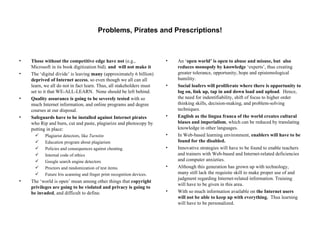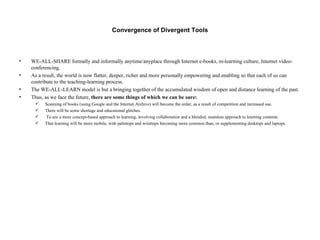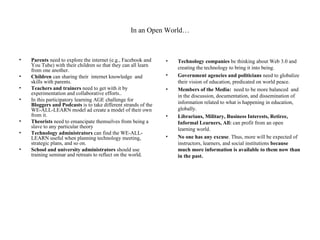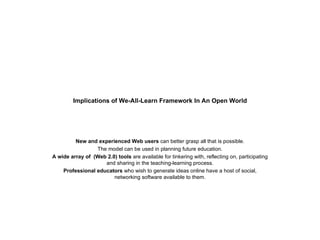Treasures And Traps Of This Open Learning World
- 1. The World is Open Chapter 12 Summary Submitted by Dennis McKoy Look Out! Treasures and Traps in an Open World
- 2. LOOK OUT! TREASURES AND TRAPS IN AN OPEN WORLD Four Tactics Used to Show That the World of Learning is Open Stories that make the facts, figures, and references concerning people who have added to the learning information world Extensive facts, figures, research results, and related references for those who need them. Web links for all projects, tools, and resources referred to in the book. WE-ALL-LEARN model â a framework for adapting to technology for learning.
- 3. TEN OPENERS: W eb Searching in the world of e-Books E -Learning and Blended Learning A vailability of Open Source and Free Software L everaged Resources and Open Course Ware L earning Object Repositories and Portals L earner Participation in Open Information Communities E lectronic Collaboration and Interaction A lternative Reality Learning R eal-Time Mobility and Portability N etworks of Personalized Learning
- 4. Superstructure for Discussing the Ten Educational Openers The availability of tools and infrastructure for learning (the pipes) The availability of free and open educational content and resources (the pages) Movement towards a culture of open access to information, international collaboration, and global sharing (a participatory learning culture).
- 5. Web of Learning Connectivism Awaits âĶ Learners: career advancement, lifelong learning, self-esteem, personal fulfillment, and economic needs, plus complete degrees and other credentials. Instructors who wish, may connect to Moodle , Sakai , and Drupal for : Free educational materials and additional supportive contents , such as online cases, simulations, and scenarios can visit such sites as MRRLOT, Connexions, Curriki . Online course management systems to upload course contents and manage online classes Communication with free synchronous chat, discussion forums, wiki, blogs, and social network tools (such as Web 2.0). All: for formal and informal social and learning communities and users, there are such blended learning facilities and innovations as You Tube, Podcast, online news and newspaper to suit the taste, preferences, and convenience of anyone, anywhere. So, WE-ALL-LEARN.
- 6. Prophesies and Predictions No one will be left behind. The âdigital divideâ will be a thing of past. There will be Internet service for all. Selah ! Some you coaches and mentors will be promoted to positions of advisors, developers or supervisors, with an E attached to your titles. So, instead of being of being a mentor or developer, you will be e- mentors and developers. Selah ! Learning will be life-long. Terabyte will shift information from your desktops and lap to the palm of our hand and your wrist. The âheadâ will be more important that the will be more important than the âhandsâ and âfeet.â Society and learning communities will be multiple-option. Personalized and portfolio learning will proliferate. Classroom space will be anyplace; classmates will be anyone/anyone; communication tools (ePals, Ning, Facebook, etc) will be selected based on needs and contexts Teachers and trainers will be available to all. Blending of teaching and learning styles, content, and technologies will mean that no style or set of styles will be a sacred cow. Multiple-option will mean that learners will select mentors, coaches, content, and styles based on needs and preferences. Blending of teaching and learning styles, content, and technologies will mean that no style or set of styles will be a sacred cow. Multiple-option will mean that learners will select mentors, coaches, content, and styles based on needs and preferences. Blending of teaching and learning styles, content, and technologies will mean that no style or set of styles will be a sacred cow. Multiple-option will mean that learners will select mentors, coaches, content, and styles based on needs and preferences. With worsening of economic conditions, globally, innovative ways will have to be found to make education cheaper poorer for the more vulnerable economies, otherwise WE-All-LEARN will be no more than just a nice sounding mnemonic. Authentic and performance-based challenges will be overcome by advances in technology. In the area of information processing, a greater than Alexandrian library is being ushered in with the dawn of digitization (e.g., Google Book Search) and new, emerging technologies (e.g., Flash and iPods). Also, the teaching-learning environment will continue to be more participatory and dialogical. In addition, constructivism will finally yield place to Connectivism : which connects everything and everyone to everyone, on a anytime/anywhere basis.
- 7. Problems, Pirates and Prescriptions! Those without the competitive edge have not (e.g., Microsoft in its book digitization bid). and will not make it The âdigital divideâ is leaving many (approximately 6 billion) deprived of Internet access , so even though we all can all learn, we all do not in fact learn. Thus, all stakeholders must set to it that WE-ALL-LEARN. None should be left behind. Quality assurance is going to be severely tested with so much Internet information, and online programs and degree courses at our disposal. Safeguards have to be installed against Internet pirates who Rip and burn, cut and paste, plagiarize and photocopy by putting in place: Plagiarist detectors, like Turnitin Education program about plagiarism Policies and consequences against cheating. Internal code of ethics Google search engine detectors Proctors and randomization of test items. Future Iris scanning and finger print recognition devices. The âworld is openâ mean among other things that copyright privileges are going to be violated and privacy is going to be invaded , and difficult to define. An â open worldâ is open to abuse and misuse, but also reduces monopoly by knowledge âexpertsâ, thus creating greater tolerance, opportunity, hope and epistemological humility. Social loafers will proliferate where there is opportunity to log on, link up, tap in and down load and upload . Hence, the need for indentifiability, shift of focus to higher order thinking skills, decision-making, and problem-solving techniques. English as the lingua franca of the world creates cultural biases and imperialism , which can be reduced by translating knowledge in other languages. In Web-based learning environment, enablers will have to be found for the disabled. Innovative strategies will have to be found to enable teachers and trainers with Web-based and Internet-related deficiencies and computer anxieties. Although this generation has grown up with technology, many still lack the requisite skill to make proper use of and judgment regarding Internet-related information. Training will have to be given in this area. With so much information available on the Internet users will not be able to keep up with everything. Thus learning will have to be personalized.
- 8. Convergence of Divergent Tools WE-ALL-SHARE formally and informally anytime/anyplace through Internet e-books, m-learning culture, Internet video-conferencing. As a result, the world is now flatter, deeper, richer and more personally empowering and enabling so that each of us can contribute to the teaching-learning process. The WE-ALL-LEARN model is but a bringing together of the accumulated wisdom of open and distance learning of the past. Thus, as we face the future, there are some things of which we can be sure: Scanning of books (using Google and the Internet Archive) will become the order, as a result of competition and increased use. There will be some shortage and educational glitches. To see a more concept-based approach to learning, involving collaboration and a blended, seamless approach to learning contents. That learning will be more mobile, with palmtops and wristtops becoming more common than, or supplementing desktops and laptops.
- 9. In an Open WorldâĶ Parents need to explore the internet (e.g., Facebook and You Tube) with their children so that they can all learn from one another. Children can sharing their internet knowledge and skills with parents. Teachers and trainers need to get with it by experimentation and collaborative efforts.. In this participatory learning AGE challenge for Bloggers and Podcasts is to take different strands of the WE-ALL-LEARN model ad create a model of their own from it. Theorists need to emancipate themselves from being a slave to any particular theory Technology administrators can find the WE-ALL-LEARN useful when planning technology meeting, strategic plans, and so on. School and university administrators should use training seminar and retreats to reflect on the world. Technology companies be thinking about Web 3.0 and creating the technology to bring it into being. Government agencies and politicians need to globalize their vision of education, predicated on world peace. Members of the Media: need to be more balanced and in the discussion, documentation, and dissemination of information related to what is happening in education, globally. Librarians, Military, Business Interests, Retiree, Informal Learners, All: can profit from an open learning world. No one has any excuse . Thus, more will be expected of instructors, learners, and social institutions because much more information is available to them now than in the past.
- 10. Implications of We-All-Learn Framework In An Open World New and experienced Web users can better grasp all that is possible. The model can be used in planning future education. A wide array of (Web 2.0) tools are available for tinkering with, reflecting on, participating and sharing in the teaching-learning process. Professional educators who wish to generate ideas online have a host of social, networking software available to them.
